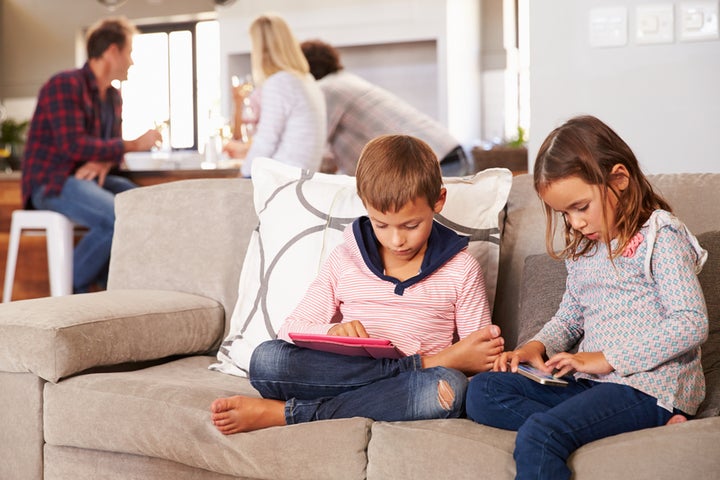
Kids on device while parents chat
The parent child relationship has changed beyond recognition in the past century. This has partly resulted from the rapid transition of child-rearing from being a community-based activity to a more individualistic activity. Another reason for the change has been the attitude towards having a child – what was once a default activity has now become a voluntary one and most parents have children by choice and not chance, which changes the dynamics and perceptions of parenting. This combination has led to more conscious parenting choices, in addition to fancy buzzwords that may or may not make sense - attachment parenting, natural parenting, positive parenting, slow parenting, helicopter parenting, tiger parenting and my personal favourite (in terms of absurdity of the term) – freerange parenting. A recent research paper reported in The Journal of Abnormal Child Psychology, which examined parenting changes among thousands of parents of 16-year-old teens in 1986 and fairly similar parents in 2006, found that recent parents have greater expectations in relation to going to school, doing homework, being polite, telling parents where they will be going, etc. and monitor children more the 1986 parents.
Perhaps the greatest change in parent-child relationship has occurred in the past two decades, with the advent of the digital age. This change is most noticeable in the relationship between an adolescent child and the parent. Adolescence is commencement of individuation, and the physical, mental and emotional health of the child during this period is critically dependent on the relationships and changes of it within the family, and in particular with parents.
The knee-jerk reaction is to believe that the digital age has deteriorated the relationship between the parent and adolescent child. Having an adolescent child, myself, the sense of righteous indignation that this belief creates in me is almost comforting. “I never spoke back at my parents”. “Put that tablet away when you are eating”. “Look at me when I a talking to you”, “Your grades are down because you are on social media all the time”, “Talk to grandpa instead of staring into your phone” – the complaints and resulting relationship stressors are endless.
But, a more rational approach shows that such stressors have always existed in different avatars and technology has in fact improved the relationship between the parent and adolescent child. The digital native adolescent consumes approximately 12 hours of digital media per day in talking, texting and chatting with her various concentric circles of family, friends and acquaintances. Naturally, digital technology has become a predominant mode of communication within families and has undoubtedly extended the opportunities and increased frequency of interaction between the parent and adolescent. The digital age has altered the heirarchial nature of conventional parent-child relationship into a form that is more equal, intimate, and egalitarian than it has been in the past.
Four integral features of digital communication have influenced the parent-child relationship in the past decade -
- Persistence: “Forgive and forget”, the maxim of traditional communication, has morphed into “forgive but persist” in digital communication. Interaction, which is the basis of relationships, can be pleasant or less than pleasant, and while the permanence of digital interaction may benefit pleasant interaction, unpleasant interactions, which are best when ephemeral, now have a permanent digital footprint. This may or may not affect the parent child relationship.
- Changeability: Technology, as some claim half in jest, is perpetually in beta stage. The high turnover rate of technology tools, and the ease with which the digital native adolescent adapts to it, leaves the parent often in a state of lag. The communication gaps and mismatch can affect the parent-child relationship in subtle ways. This is, however, passe, and may be restrictred to merely one generation of parents who belonged to the era of digital revolution rather than assimilation. A recent U.S. report states that young parents have become much more comfortable with communication technologies than the earlier crop of parents and the digital divide could not be an issue after all.
- Scalability: When I was an adolescent, my social circle was well within the grasp of my parents because of geographic limits. The expanse of social media makes this more difficult. The relationship between parent and child must include the element of friends and social circle, and with a digital social circle that is not only global, but also ephemeral in itself, the participation of the parent in the adolescent’s social life has become tricky.
- Access to data: While mortification was limited in the past at being dropped by a mother at the movie theatre or such like, now the easy access to data and information can sway the relationship between child and parent. My own teenager is mortified that my latest personal blog title was “My baby is growing so fast”.
The electronic tether is, nevertheless, a double edged sword. While it provides timely support to adolescents from parents and guardians, and an instant reassurance to the parent, it has been accused of stifling developmental progress through overreliance on parental (and other) guidance and helicopter parenting by the parent herself. Another concern is the conflict that arise from mismatch in parental expectations of media use by children, and the child’s indulgence in it. However, a 2013 study by Northwestern University shows that 46% of parents do not believe that such conflicts could be dilapidating, as against 3% who strongly believed so.
Yet another concern is a probable decline in time spent with one another. While the digital tools indeed allow possibility of better communication between the parent and the teen, it has been shown that joint media engagement drops off markedly for children who are six or older. Thus it seems that parents and children must put in more conscious effort to spend more time together, either using the digital tools, or excluding them in order to keep the relationship smooth and updated.
It is undeniable that in terms of parenting and parent-child relationships, the digital era is vastly different from the one that preceded it, but it must also be acknowledged that digital tools have indeed benefitted parenting in that the village that takes to raise a child is now a global village. Parents themselves are different today and as it has always been, parents have to adapt and mesh their parenting attitudes and activities with the digitally rich environment that their children are born into. It takes conscious effort and constant course correction to bypass the pitfalls of digital tools and enhance the riches that these tools bring into the parent-child bond.
Writing credit: Co-authored by Lakshmi, a Mobicip blogger & parent who strives to strike the perfect balance between technology and family.
Mobicip is the creator of the most powerful and extensive internet safety software for tablets, smartphones and computers in households today. Learn more at www.mobicip.com.
